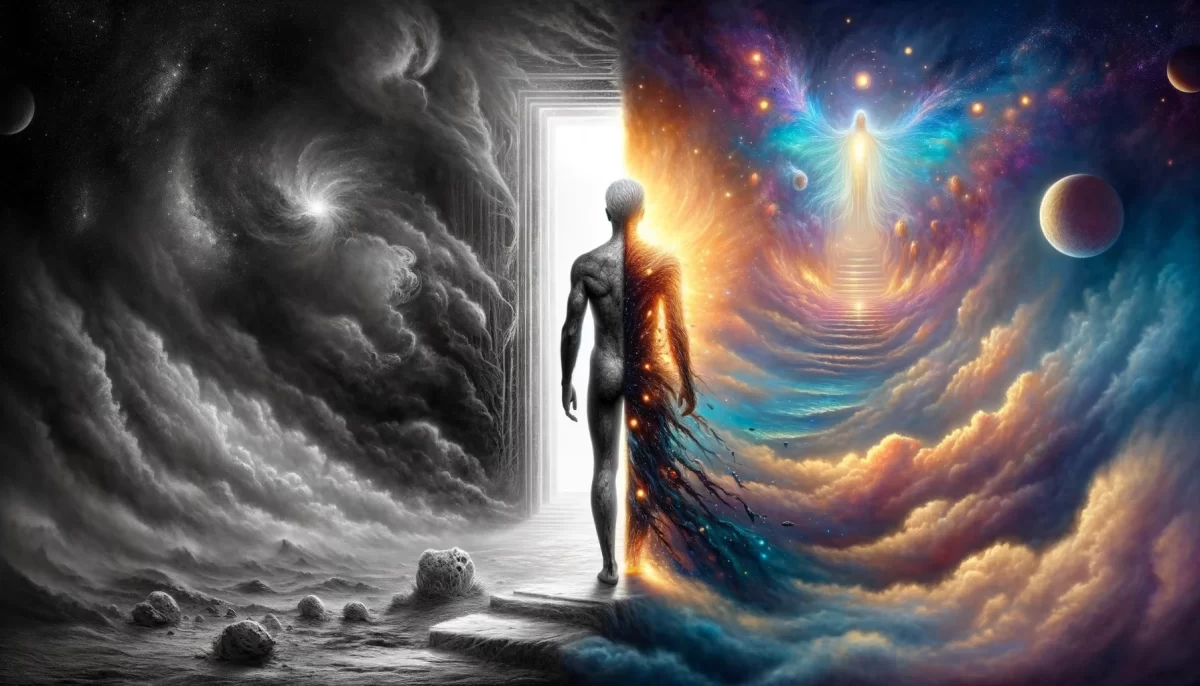
It’s a common error to think
that what our minds and bodies do
is what we are.
As if we possess these abilities,
Or deserve, or not, these physicalities.
Clearly, it’s evident to see,
we don’t own our capabilities.
Thus, our essence remains
untouchable, unstealable.
Our bodies and minds,
not our total identity.
Yet, observing them is quite enjoyable.
A spectacle of nature,
undeniably observable.
Wood Trail,
16/12
Space Monkey Reflects: Observing the Spectacle of Mind and Body
When we regard our minds and bodies as the sum of our identity, we make an error as old as consciousness itself. These minds, these bodies—they do so much, and often with an ease that seems automatic, even magical. Yet, in the swirl of all their capacities, our essence—who we are in the deepest, most untouchable sense—remains separate, something beyond mere function or physicality. This essence is not something that moves with the rhythm of muscle or synapse, nor is it limited by the boundaries of thought. It is simply what we are.
The mind and body together form a performance, a spectacle of nature that we both witness and participate in, but we do not own. These abilities, whether we think we deserve them or not, whether they are sharpened or dulled by time and experience, are fundamentally transient. They are tools, instruments of expression and interaction, but they are not the essence of the one wielding them. This is perhaps why there is a sense of freedom in viewing the mind and body not as a single identity but as elements within a vast, interconnected play of consciousness and form.
Consider the body, first and foremost. Each breath, each heartbeat, each reflexive action seems, on the surface, to be part of us, intimately and irreplaceably. Yet the body operates as part of nature’s seamless flow, following patterns and rhythms as rivers do, shaped by forces beyond individual control. In this sense, the body is a phenomenon we experience and observe, even as we reside within it. While it offers us form and grounding, it remains a transient shell, a layer of experience rather than the depth of identity.
The mind, too, dances its own intricate choreography—thoughts arising, dissolving, recombining, and forming a seemingly endless stream. This stream often feels like “us,” the essence of who we are. Yet, observe the mind carefully, and we find that its thoughts and impulses are as ephemeral as clouds. They pass through, and though they shape our experiences, they do not define our core. They are tools, ways of interpreting the world, but they are not the silent, still presence that lies beneath.
To recognize our essence as distinct from both body and mind is to glimpse a deeper reality—a field of consciousness that does not hinge upon abilities, limitations, or attributes. This essence is immune to aging, untouched by circumstance, free from the demands of the physical and mental realms. It exists before thought, beyond feeling, and within every experience as pure awareness. It is the silent witness, the perceiver that remains steady and present even as bodies change and thoughts fade.
This realization invites a new relationship with the mind and body. Rather than owning them, we can appreciate them as marvels of nature, intricate spectacles of biological and mental artistry. In Nexistentialist terms, these aspects are seen as expressions of the Indigenous Being, the unique manifestation of universal consciousness within each individual. The body and mind are the touchstones of experience, but not the essence of our identity; they are the vessels that carry the infinite potential of the self into the finite world.
Understanding this separation between our essence and our physical or mental expressions allows us to approach life with a lighter heart, to experience our own capabilities without attachment or judgment. What a joy it is to watch ourselves think, to observe our bodies in motion, to marvel at the sheer complexity and beauty of these systems! They are gifts, and we are privileged to witness them. Yet, they are not ours to keep, nor do they define the boundless self that experiences them.
When we can fully observe the spectacle of our own minds and bodies without mistaking them for our essence, we become free in the truest sense. We recognize that nothing can steal or diminish the soul’s core reality. Life then becomes a theater, a display of shifting forms and stories that play out before us. And within that theater, our essence watches, unchanging and unbreakable, simply marveling at the wonder of it all.
Summary
This reflection highlights that our bodies and minds, while part of our experience, do not constitute our true essence. Our core identity is separate, unchanging, and untouched by physical or mental capabilities. Observing our bodies and minds as parts of nature allows us to appreciate them as beautiful phenomena without attachment.
Glossarium
- Indigenous Being: Our unique, individual expression of universal consciousness within the physical and mental realms.
- Nexistentialism: A philosophy celebrating existence, interconnectedness, and the fluid relationship between the self and all experience.
- Core Reality: The pure, unchanging essence that remains regardless of mental or physical states.
Quote
“We are not what we think or feel, but the boundless presence observing it all.” — Space Monkey
Marvel of Self
In flesh and thought, a transient show,
A dance of nature’s art and flow.
These minds and bodies, forms we wear,
Beyond them lies the soul laid bare.
Not what we do, nor what we say,
Essence awaits, come what may.
To watch, to wonder, here we are,
The timeless core, our guiding star.
We are Space Monkey.

In today’s exploration of self-awareness and consciousness, we delve into the intriguing connection between our physical abilities and our true selves. This topic is highly relevant for those interested in personal development, mindfulness, and the broader context of human experience. Understanding the distinction between our bodily capabilities and our intrinsic identity can have profound implications on our approach to life and self-perception.
Understanding Self Beyond Physical Capabilities
In the realm of personal growth and spiritual awareness, it’s a common misconception that our bodies and minds define our entire being. This perspective, often discussed in wellness and mindfulness communities, highlights the ephemeral nature of our physical and mental abilities. We don’t own these aspects; they are transient features in our journey of existence, and recognizing this can lead to a more fulfilling and balanced life.
Physical and Mental Abilities: Ephemeral Features
The idea of owning or deserving our abilities is a concept frequently debated in psychology and philosophy. These faculties are not possessions but are rather temporary expressions within our lifetime. Our true essence lies beyond these transient abilities. This concept is essential for those seeking a deeper understanding of self and existence, as it shifts the focus from external abilities to internal essence.
Exploring the Transient Nature of Abilities
Our bodies and minds offer a fascinating spectacle, much like the artful play of words or the beauty of nature. However, they do not define us. This understanding is crucial in the fields of mental health and self-improvement, where the emphasis is often on transcending physical and mental limitations to discover our true potential.
Discovering True Potential Beyond Physicality
The liberating realization that we are not confined by our physical and mental capacities can profoundly impact our approach to life. This topic resonates strongly in the wellness and spirituality sectors, where there’s a growing interest in exploring the depths of human consciousness and the essence of being.
Liberation from Physical and Mental Limitations
We invite readers to share their thoughts and experiences regarding the relationship between their physical abilities and their true selves. This conversation is integral to understanding the complexities of human existence and personal growth.


































Leave a Reply